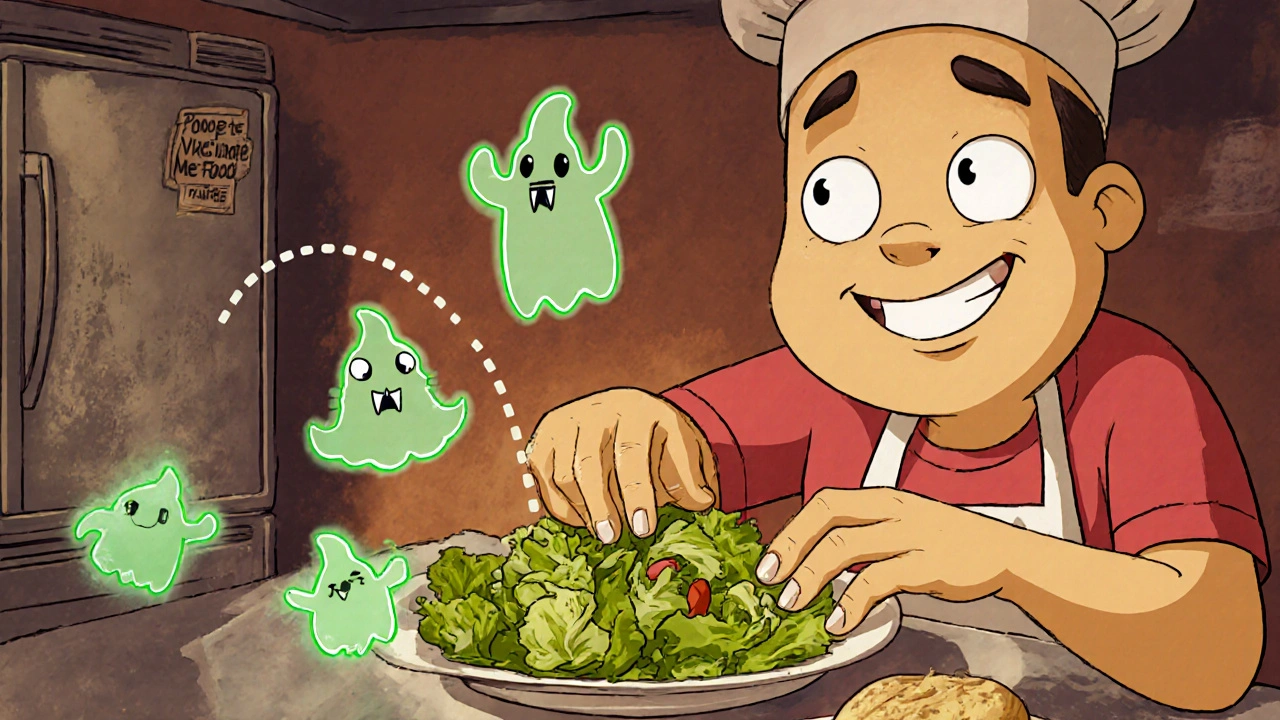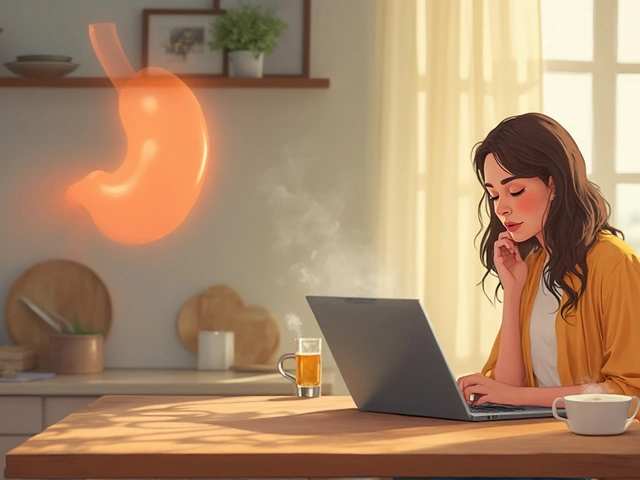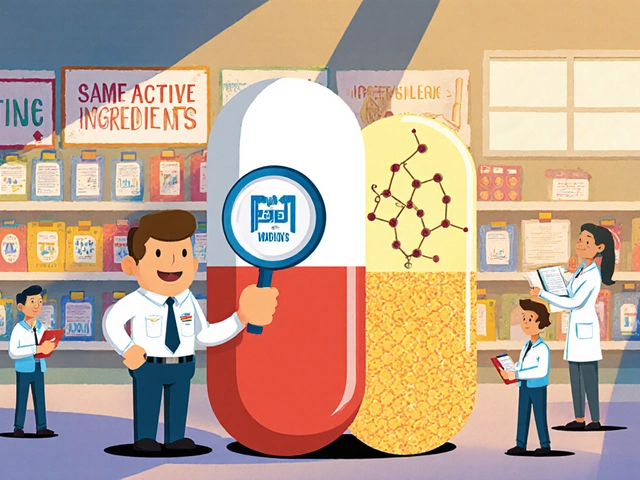Every year, around 1.4 million people get hepatitis A worldwide. Most don’t realize they caught it from something they ate. It’s not just dirty hands or bad hygiene-it’s a quiet, invisible threat hiding in salads, sushi, sandwiches, and shellfish. The virus doesn’t care if you’re healthy or young. It only needs 10 to 100 particles to infect you. And once it’s on your food, it can survive for weeks-even in the fridge or frozen. Hepatitis A isn’t like the flu. You don’t sneeze it out. You don’t catch it from a cough. It travels through poop. And when someone with the virus doesn’t wash their hands after using the bathroom, those particles get on their skin, then on the food they touch. One infected food worker can spread it to dozens, sometimes hundreds, of customers. In 2023, a single outbreak in a California restaurant led to over 180 cases and $420,000 in public health costs. That’s not rare. It’s becoming more common. The virus is tough. It laughs at soap and water alone. It survives heat up to 60°C for a full hour. That’s why undercooked shellfish from polluted waters are a major risk. It lingers on stainless steel surfaces for 30 days. It stays active in dried lettuce for four weeks. And it doesn’t care if the food looks clean. You can’t see it. You can’t smell it. You can’t taste it. The worst part? Most people don’t even know they’re sick-yet they’re still contagious. About 30% to 50% of hepatitis A infections show no symptoms at all, especially in kids. But they’re still shedding the virus in their stool. They wash their hands, maybe. They go back to work. They handle sandwiches. They touch lettuce. And they pass the virus on without ever feeling sick. This is why food safety isn’t just about cleaning surfaces. It’s about knowing who’s infected, when they were exposed, and what to do next. How do you know if you’ve been exposed? If you ate at a restaurant where a worker was later confirmed to have hepatitis A, you might be at risk. The same goes for eating raw oysters from a contaminated harvest area, or sharing food with someone who later got sick. The virus takes 15 to 50 days to show symptoms-average is 28 days. But you’re contagious for up to two weeks before you even feel bad. That’s why timing matters more than anything else. If you think you’ve been exposed, you have just 14 days to act. After that, post-exposure prophylaxis (PEP) won’t work. What is post-exposure prophylaxis (PEP)? There are two options, and the choice depends on your age and health. For people aged 1 to 40, the best option is a single shot of the hepatitis A vaccine. It’s fast. It’s safe. And it gives you protection for at least 25 years. Brands like Havrix and Vaqta are widely used. The cost? Around $50 to $75 per dose. For people over 40, those with chronic liver disease, or anyone with a weakened immune system, the choice is immune globulin (IG). It’s a shot of antibodies taken from donated blood. It works fast-but only lasts 2 to 5 months. It costs $150 to $300 per dose. Neither option gives you instant protection. You still need to be careful for the next six weeks. That means: no bare-hand contact with ready-to-eat food. No cooking for others. No sharing utensils. Wash your hands constantly. Even if you feel fine. The CDC says PEP reduces infection risk by 85% if given within 14 days. But if you wait longer? The chance of catching it jumps dramatically. What happens if you’re a food worker and you get infected? If you work in a kitchen and test positive for hepatitis A, you’re not allowed back until you’re no longer contagious. That’s at least 7 days after jaundice appears-or two weeks after symptoms start, whichever is later. In California, it’s 14 days from symptom onset, no exceptions. You can’t just come back when you feel better. You can’t go back after a week of rest. The virus is still in your stool. Your hands are still dangerous. And here’s the harsh truth: most food workers don’t know this. A 2025 study found only 35% of kitchen staff could name the symptoms of hepatitis A. Only 28% knew the 14-day window for PEP. And in fast-food places, staff turnover hits 150% a year. New hires come in. No training. No vaccination. No idea what they’re risking. Why isn’t everyone vaccinated? The CDC has recommended hepatitis A vaccination for food handlers since 2006. But in 2023, less than 30% of food service workers in the U.S. were vaccinated. In seasonal jobs-think summer beach stands, holiday food trucks-it drops to 15%. Why? Cost. Lack of time. Language barriers. High turnover. Many employers don’t pay for it. Workers don’t have insurance. Or they think, “I’m healthy. I won’t get sick.” But here’s what they don’t realize: it’s not about you. It’s about the people who eat your food. In Iowa, a single outbreak in a deli led to 67 infections. The restaurant shut down for three weeks. The owner paid $180,000 in lost revenue, legal fees, and public health fines. The vaccine cost $50 per employee. The outbreak cost 3,600 times more. A 2022 analysis showed for every $1 spent on vaccinating food workers, $3.20 was saved in outbreak response. What’s being done to fix this? More states are stepping in. As of January 2024, 14 U.S. states now require hepatitis A vaccination for food handlers. California’s 2022 mandate prevented an estimated 120 infections and saved $1.2 million in public health costs. Some restaurants are starting to pay for shots. Others are offering $50 bonuses to employees who get vaccinated. Early results show that increases vaccination rates by 38 percentage points. New tools are coming too. Scientists are testing wastewater monitoring in restaurant drains. They can detect the virus in sewage before anyone gets sick. One pilot study caught asymptomatic carriers with 89% accuracy. Point-of-care blood tests are in final trials. In five years, a food worker might get a quick finger-prick test at the start of their shift-and know if they’re shedding the virus. And more restaurants are using gloves and tongs for ready-to-eat food. But only 42% do it consistently. Over 75% of food establishments still allow bare-hand contact with sandwiches, salads, and sushi. What can you do? If you’re a customer: ask. Did the person handling your food wash their hands? Are they using gloves? If you’re unsure, choose cooked food over raw. Avoid raw shellfish unless you know the source. If you’re a food worker: get vaccinated. Even if your employer doesn’t require it. Even if you think you’re safe. The vaccine is one shot. It lasts decades. It protects your customers. It protects your job. If you’ve been exposed: act fast. Go to your doctor or local health department within 14 days. Don’t wait. Don’t assume you’re fine. Get the shot. Follow the rules. Wash your hands like your life depends on it-because it does. How to prevent hepatitis A at home You don’t need to be a chef to stop this virus. - Wash your hands with soap and water for at least 20 seconds after using the bathroom, before cooking, and before eating. Water alone cuts risk by 30%. Soap cuts it by 70%. - Don’t eat raw shellfish from unknown sources. Check where it was harvested. If it’s from a polluted area, skip it. - Wash fruits and vegetables under running water-even if you plan to peel them. The skin can carry the virus. - Clean kitchen surfaces with bleach-based cleaners. HAV survives on counters, cutting boards, and fridge handles. - If someone in your home has hepatitis A, disinfect bathrooms daily. Use separate towels. Don’t share utensils. Who’s at highest risk? - Food service workers - People who travel to countries with poor sanitation - People who use recreational drugs - Men who have sex with men - People with chronic liver disease - Homeless populations - Children in daycare centers But here’s the thing: you don’t have to be in one of these groups to get infected. The virus doesn’t ask questions. It just waits-for a dirty hand, a contaminated salad, a moment of carelessness. What happens if you get sick? Most people recover fully. No long-term damage. No chronic hepatitis. Symptoms come on slowly: fatigue, fever, nausea, dark urine, clay-colored stools, and jaundice (yellow skin and eyes). It lasts weeks to months. But you’re not contagious forever. Once jaundice appears, you’re less likely to spread it. Diagnosis is simple: a blood test for HAV IgM antibodies. It shows up 5 to 10 days before symptoms. That’s how health officials trace outbreaks. There’s no cure. No antiviral drug. Just rest, fluids, and time. That’s why prevention is everything. Final thought Hepatitis A isn’t a disease of the past. It’s a disease of systems-broken training, ignored guidelines, low vaccination rates, and silent transmission. It’s not about blame. It’s about action. One shot. One handwash. One rule followed. That’s all it takes to stop it. And if you’re reading this because you’re worried you’ve been exposed? Don’t wait. Call your doctor today. The clock is ticking. And 14 days? It’s not a suggestion. It’s your last chance.
Hepatitis A: How Food Contamination Spreads the Virus and What to Do After Exposure
- Home
- Hepatitis A: How Food Contamination Spreads the Virus and What to Do After Exposure







12 Comments
bro i just ate sushi last night and now im paranoid lol
never thought about poop on food being a thing but makes sense
my grandma always said wash hands but damn this is next level
this is all government propaganda to push vaccines. you know who controls the food industry? Big Pharma. they profit when you get sick. why do you think they made the vaccine so expensive? they want you dependent. also, hepatitis A is just a myth invented by the CDC to scare people into getting shots. i checked the WHO website and it says nothing about this.
holy crap i had no idea this virus was this sneaky
like imagine working at a sandwich shop and you’re fine but you’re silently spreading it for weeks
and the worst part? you don’t even know you’re doing it
my cousin works at a taco truck and she’s never been vaccinated
i’m texting her right now to go get the shot
interesting read. i work in hospitality in the uk and we get trained on hygiene but never specifically on hepatitis A. i think this should be standard across all food service training. simple, cheap, effective. why isn’t this mandatory everywhere?
the real tragedy here is how we treat prevention like an afterthought
we’ll spend millions treating a disease but won’t spend $50 to stop it
it’s not about blame
it’s about how broken our systems are
we reward speed over safety
profit over people
and then act shocked when things go wrong
my aunt got hepatitis A from a salad at a diner in texas
she was fine one day, then spent three weeks in bed
weird part? the worker who made her salad never even got sick
she just washed her hands after the bathroom and went back to work
no gloves, no training, no clue
so i got vaccinated last month
just in case
in india we call this "dirty hands, dirty food"
but honestly? it’s not just about handwashing
it’s about power
who gets to eat clean food? who gets trained? who gets vaccinated?
the poor? the migrants? the workers?
they’re the ones holding the knives
and the ones getting blamed
we need systemic change, not just shots
Wait. So you’re saying that if I eat a salad, I could get hepatitis A? From... someone’s poop? On the lettuce? That’s... insane. I mean, really? And you’re telling me I need to get a shot? What if I’m allergic? What if I’m pregnant? What if I don’t have insurance? What if I don’t believe in vaccines? What if I’m just... tired? What if I don’t want to? What if I don’t care? What if I’m right? What if I’m wrong? What if-
i’ve worked in food service for 12 years and no one ever told me about this
we got trained on cross-contamination and allergens, but never hepatitis A
the first time i heard about the 14-day window was reading this post
now i’m going to my clinic tomorrow
and i’m telling every coworker i know
you don’t have to be a hero to save someone’s life
you just have to show up
nah bro this is all fake news. hepatitis A? more like hepatitis BORING. nobody gets sick from salad anymore. we got air purifiers and hand sanitizer. also, the FDA is just trying to sell more vaccines. i ate raw oysters in australia and i’m still standing. you guys are too scared to live.
this hit different. my dad’s a cook. he’s 62. he’s never been vaccinated. i’m calling him right now. i’m sending him this post. i’m paying for his shot. he doesn’t need to be a hero. he just needs to be safe. and so do the people who eat his food.
This article is a classic fear-mongering piece designed to make people panic and buy vaccines. The CDC has a vested interest in promoting fear-based public health campaigns. Also, the cost of the vaccine? Ridiculous. And the fact that you’re blaming food workers? Pathetic. If you’re so worried about hepatitis A, why not just stop eating out? Or better yet-stop being a lazy consumer who expects everything to be perfect without lifting a finger? The real problem is people who think they’re entitled to food safety without personal responsibility.